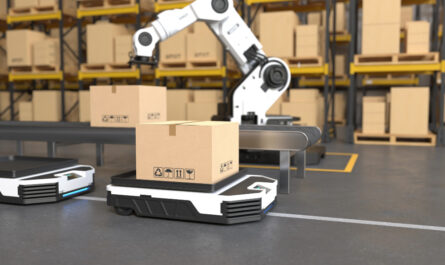When it comes to the fast-paced world of making stuff, it’s not just about having fancy tech and top-notch machines. The key to success is having a smart plan for how you make things.
Think of it like the backbone of your operation. This plan makes sure you use your resources wisely, stick to your schedule, and keep costs in check.
In this blog post, we’re going to break down the top 10 tips for making a killer production plan that can take your business to the next level.
Before we go further into this topic, don’t forget to follow my LinkedIn account. You’ll get more helpful insights on supply chain management there.
Table of Contents
Data-Driven Decision Making
Let’s talk about the cool changes happening in the world of manufacturing, thanks to Industry 4.0. It’s all about data, and trust me, it’s a big deal in production planning. We’re in an era where data is like the king, calling the shots and guiding our moves. To really shine in this setup, we’ve got to shift our production planning to be all about accurate and real-time data analysis.
Picture this: we use super-smart tools that can handle all kinds of data, from tricky customer demand patterns to nitty-gritty machine performance numbers. The trick is turning all that info into smart insights that help us make informed decisions.
Going all-in on a data-driven approach means we can boost how good we are at predicting things, like what the market wants. Plus, it’s like having a shield against problems because we can spot and fix issues fast. And hey, it opens up chances to make things even better, always refining how we do stuff for top-notch results.

In this era where data is the boss, using fancy analytics isn’t just about crunching numbers—it’s the secret sauce to being strong and competitive. Thanks to data-driven insights, companies can take their production planning to the next level. This means we’re not just making guesses; we’re making choices that match what’s really going on in the world. Using top-notch analytics isn’t just about making decisions easier; it’s about staying flexible when the market changes.
So, when production planning and data insights team up, it’s like a superhero duo, helping us adapt and get better in the ever-changing world of making things.
Collaborative Planning
Let’s talk about making production planning work like a charm. The secret sauce? Breaking down those pesky organizational silos. Imagine it like tearing down invisible walls between departments, so everyone can team up and make magic happen.
The key player here is collaborative planning—a fancy term for a smart strategy. It’s about getting insights from all corners of the organization. Think sales, marketing, and procurement all sharing their unique perspectives. When we put all these pieces together, we get a full picture of what’s happening in the market, what resources we have, and the big goals we’re aiming for.
Now, how do we make this happen? It’s all about using cool tools like collaborative planning software. These tools make sure everyone can chat easily and share important info.
So, instead of working in separate bubbles, we’re all on the same page. This collaboration isn’t just about talking; it’s about creating a shared understanding that makes production planning way more effective.
Breaking down those silos isn’t just good for teamwork; it brings loads of strategic perks. Collaborative planning fine-tunes our production plans to match what the market wants. Plus, it helps us keep an eye on the resources we’ve got.

Mixing ideas from different departments makes our approach to planning dynamic and quick on its feet. And guess what? When we weave business goals into our production plans, we’re not just making things; we’re making things that match the big goals of the whole organization.
The bonus? Everyone feels part of the action. Shared responsibility and teamwork become the norm, creating a culture where everyone pitches in. That’s the magic of breaking down silos and bringing everyone together for top-notch production planning.
You might also like:
- What are the Differences in Skill Sets Required for Automotive and FMCG Supply Chain?
- Supply Chain Transparency: Not About Dropping Underperforming Departments
Capacity Planning and Optimization
Let’s dive into the heart of making production planning work like a charm. It all boils down to understanding and optimizing our production capacity—how much we can actually make. Think about it like checking out our machinery, the awesome folks on our team, and the places where the magic happens.
When we really get into the nitty-gritty of our production capacity, we’re looking for the sweet spots and potential hiccups. This means figuring out what our operation can handle and finding spots where we can do even better. It’s like sizing up our strengths and limits to build a production plan that’s ready for anything the market throws at us.
Now, how do we turn this knowledge into action? We’re talking about using some cool tools that let us visualize and simulate different production scenarios. It’s like playing around with a virtual model of our production process. This way, decision-makers can test out different situations and see how they’d affect our capacity and efficiency. It’s like a crystal ball for production planning!

By trying out different scenarios in the virtual world, we can spot potential issues before they become real headaches. This lets us make tweaks and changes to our production plan before things get crazy.
The result? We can keep things running smoothly, even when the demand is through the roof. This kind of smart planning makes our production setup tough and adaptable, ready to take on whatever the market throws our way.
Demand Forecasting
Let’s chat about the key to rocking production planning: nailing demand forecasting. It’s like the secret sauce that makes everything fall into place. Being able to predict what people will want in the future helps us schedule our production perfectly.
So, how do we become demand prediction wizards? We use a mix of history, what’s hot in the market, and what customers are saying. All this info gives us the lowdown on what people like and when they’ll want it. And guess what? Thanks to super-smart tech like artificial intelligence and machine learning, we’ve taken demand forecasting to a whole new level. These tech marvels dig into massive data sets, spotting patterns we might miss, and making our predictions super spot-on.
Why does this matter? Well, when we sync up our production schedule with what we’ve predicted people will want, magic happens. We can avoid having too much stuff lying around (saving us money), and we can dodge the risk of having goods that nobody wants.
On the flip side, matching production with demand means we don’t run out of products when customers are looking for them. It’s like a dance, finding that perfect balance between making just enough and having it ready when people want it.
This harmony between what we make and what people want isn’t just good for our storage space; it’s a game-changer for keeping customers happy. Imagine always getting what you want when you want it—pretty awesome, right? That’s the power of accurate demand forecasting. It’s not just a tool; it’s a must-have strategy that keeps our production on point and makes everything run like clockwork.
Lean Manufacturing Principles
Let’s dive into something super cool: lean manufacturing. It’s like the rockstar of production planning, bringing some serious game-changing vibes. At its heart, lean manufacturing is a smart approach that’s all about kicking waste to the curb, making processes top-notch, and boosting overall efficiency from start to finish in the production cycle.
Imagine this: every nook and cranny of our operations gets a close look. We’re on a mission to spot and kick out anything that doesn’t add value and just slows us down. By always aiming for improvement and cutting out waste, lean manufacturing not only makes our final products top-notch but also makes our whole production planning process flexible and responsive.
Now, let’s talk about the superheroes in lean manufacturing—Just-In-Time (JIT) manufacturing and the Kanban system. JIT manufacturing is like a ninja move—it’s all about making stuff exactly when we need it, so no excess inventory is hanging around. This not only saves us money but also keeps our workflow in sync with what customers want.
And then, there’s the Kanban system—a visual superhero that helps us keep everything flowing smoothly. It’s like having a real-time map showing us where things are in the production cycle. With this visual guide, we can cut down on waiting times, plan things more precisely, and keep the production dance in tune with what the market demands.
When we bring these lean manufacturing superstars together, it’s like building a rock-solid foundation for production planning. It’s not just about making things efficient; it’s about being super responsive to what the market needs. Lean manufacturing is like the rock and roll of production planning, making everything click in the coolest way possible.
You might also like:
- 20 Factors to Consider When Deciding Whether to Make or Buy
- 15 Ways to Create a Transparent Supply Chain
Risk Management
Let’s talk about keeping things smooth in production planning. Sure, being efficient is a big deal, but there’s another side we can’t ignore—being ready for the unexpected twists and turns. Production settings can get hit with all sorts of surprises, like supply chain hiccups, machines deciding to take a break, or not having enough folks on the team.
To be ready for these curveballs, we’ve got to get proactive. That means doing a deep dive into all the things that could throw a wrench in our plans. Once we’ve spotted the potential pitfalls, it’s game time. We can create backup plans, sort of like a playbook for dealing with specific risks.

Why does this matter? Well, when the unexpected happens, having these backup plans is like having a superhero squad ready to swoop in. It helps us act fast and smart, making sure our production schedule stays on track and our customers stay happy. These plans might involve things like having backup suppliers, extra machines just in case, or making sure everyone on the team knows how to handle different tasks to cover for shortages.
By making risk management part of the production planning game plan, we’re not just keeping things running; we’re also building a rep for being reliable and customer-friendly. It’s like showing the world that we’re not just about making things efficiently, but we’re also ready to tackle anything that comes our way. Being proactive about risks becomes a rock-solid foundation for making production planning resilient and successful in the always-changing world of manufacturing.
Real-Time Monitoring and Reporting
Let’s dive into the buzzing world of manufacturing where things move at lightning speed. Imagine having eyes everywhere, right when you need them. That’s the magic of real-time visibility, a game-changer for keeping the production show running smoothly.
So, what’s the deal with real-time visibility? It’s like having a superpower to monitor all the important stuff instantly. Key performance indicators (KPIs) become your sidekick, giving you a quick overview of what’s happening in the production game. This real-time view is gold—it helps spot issues and bottlenecks right as they pop up.
And guess what? It puts the power in decision-makers’ hands to fix things on the fly. Being proactive like this is the secret sauce for preventing disruptions and keeping the production flow on point, even when unexpected challenges pop up.

But wait, there’s more! Real-time reporting isn’t just about putting out fires. It’s like a treasure map for making things even better. With constant access to the latest data, you get insights that light the way for making processes super slick and boosting overall efficiency. It’s like this awesome loop of keeping an eye on things, analyzing what’s happening, and making continuous improvements.
This loop isn’t just a tactical tool for solving immediate problems; it’s a strategic asset that keeps you ahead of the game. Staying competitive in manufacturing isn’t just about reacting fast; it’s about evolving and staying nimble in a market that’s always changing. Real-time visibility isn’t just a buzzword; it’s your ticket to being on top of things, solving problems pronto, and constantly getting better in the fast-paced world of manufacturing.
Flexibility and Adaptability
Let’s chat about how being flexible is the secret sauce in successful production planning. Picture this: the market is always doing its own dance, customers change their minds, and unexpected hiccups can pop up out of nowhere. To tackle these twists and turns, we need our production plans to be like superheroes—adaptable and ready for anything.
Why does flexibility matter so much? Well, it’s like having a superpower to adjust our production schedules on the fly. This means we can roll with changes in demand and keep our production processes in sync with what the market wants.
But it’s not just about reacting to surprises; it’s about being proactive. When unexpected things happen, we want to be the quick-change artists who can pivot and keep the show going without missing a beat.
Now, let’s talk about agile production planning. It’s like the superhero cape that helps us stay ahead of the competition in this fast-paced world. Being agile means we can move fast, seize new opportunities, and handle risks like pros.
With an agile approach, we can tweak our production schedules in real-time, making sure we’re using resources smartly and delivering products that match what the market is craving right now.

But the magic of being agile isn’t just about staying on top of things; it’s about creating a vibe of innovation and always getting better. Companies that embrace agile production planning aren’t just reacting to changes; they’re shaping their production strategies to be super resilient in the face of uncertainty.
So, being flexible and agile isn’t just a cool factor—it’s the key to being a superstar in the ever-changing world of manufacturing.
You might also like:
- 15 Tips for Successful Supply Chain Beginners
- 33 Strategies How to Significantly Reducing Supply Chain Lead Times
Investment in Technology
Let’s talk about staying on top of the tech game in production planning. Right now, manufacturing is going through a big makeover, thanks to cool stuff like automation, artificial intelligence (AI), and machine learning.
Embracing these high-tech tools can totally shake up how organizations plan and carry out their production strategies. It’s like giving our processes a futuristic upgrade.
So, why should we get cozy with these cutting-edge technologies? Well, they’re like superheroes for our workflows. Picture this: they can make things super smooth, predict what people will want, and even keep our machines in top-notch shape.
Take advanced planning software, for example—it’s like a wizard that helps us use resources smartly and figure out complicated schedules. Then there’s predictive maintenance, powered by AI, that’s like having a crystal ball for machines, spotting problems before they even happen.
And don’t forget about the Internet of Things (IoT)—those connected devices give us real-time insights into how our machines are performing, helping us make smart decisions based on data.
Now, here’s the cool part: investing in these tech wonders isn’t just a quick fix. It’s a smart move for long-term success in the competitive world of manufacturing. As the industry keeps evolving, organizations that ride the tech wave set themselves up for steady growth and toughness. Using these advanced tools isn’t just about making today’s operations smooth; it’s about future-proofing our organization against whatever challenges might come our way.
By always exploring and integrating new technologies, businesses can be the cool kids on the block, adapting to trends, and meeting the ever-changing demands of the market. In this era of Industry 4.0, where manufacturing is getting a digital makeover, organizations that invest wisely in tech for production planning are paving the road for a sustainable and super successful future.
Continuous Improvement Culture
Let’s talk about the journey to perfect production planning—it’s like an ongoing adventure that needs a mindset of always getting better. Imagine a workplace where everyone’s excited to find ways to improve instead of just settling for the status quo. That’s the kind of culture we’re talking about—one that’s all about constant improvement.

So, how do we make this happen? Well, it starts with encouraging the team to be on the lookout for inefficiencies. We want everyone to feel like they can suggest cool ideas and share what they’ve learned on the job.
This way, the whole crew is working together to make production processes even better. Think of it as a team effort where every challenge is a chance to shine and improve.
But that’s not all! A big part of keeping this improvement vibe going is having solid training programs. These programs make sure everyone has the latest skills and knows what’s up with the newest industry trends and technologies.
With continuous training, the team not only gets better at what they do but also becomes super adaptable and ready for any changes that come their way. It’s like giving everyone the tools to keep production planning strategies flexible and responsive to whatever the business landscape throws at us.
By always checking and fine-tuning how things are done, organizations not only stay ahead but also create this awesome culture of innovation. It’s like a cycle of always getting better, and that’s what propels us towards being top-notch and successful in the long run. So, it’s not just about being perfect once—it’s about making improvement a way of life in the world of production planning.
Conclusion
Let’s wrap it up. Think of effective production planning like the superhero that holds the whole show together in successful manufacturing. Now, we’ve got this guide with the top 10 best practices, and it’s not just a smart move—it’s a journey towards being super awesome at what we do.
By jumping on board with these practices, organizations can gear up to be efficiency masters, strategically cut costs, and keep rocking in the ever-changing world of modern manufacturing. It’s not just about doing one thing right; it’s about taking a well-rounded approach—from using data-driven insights to making a culture of always getting better.
Now, why does this matter? These best practices aren’t just random tips; they’re building blocks for creating a production planning strategy that’s tough and ready for the future. In a world where being adaptable is key, organizations that embrace these principles get a leg up. But here’s the secret sauce: it’s not about following these practices word for word. It’s about customizing them to fit the unique needs of your organization.
As you dive into this journey of transformation, you’ll see the impact. Your production game will hit new heights, not just in how smoothly things run but in driving growth and making your organization a big deal in the manufacturing world. So, let’s get ready to turn these best practices into real-world success and take production planning to the next level!
I hope you find it helpful!
Please share this article with your colleagues so they can also benefit. For more insights on supply chain management, follow my LinkedIn account. You’re free to use all articles on this blog for any purpose, even for commercial use, without needing to give credit.
 by
by 

